The General Post Office (GPO) in Dublin stands as a monumental edifice in the heart of O’Connell Street, formerly known as Sackville Street. Opened to the public in January 1818, the GPO was designed by the renowned architect Francis Johnston in the Greek Revival style. Beyond its function as the principal post office in Ireland, the GPO holds a distinguished place in Irish history, most notably as the headquarters for the leaders of the 1916 Easter Rising. This pivotal event marked a significant chapter in Ireland’s quest for independence, embedding the GPO in the national consciousness as a symbol of resistance and freedom. Today, while it continues to serve its original postal purposes, the GPO also attracts visitors from around the world, drawn to its historical significance and architectural grandeur.
Contents
Historical Background
The General Post Office (GPO) in Dublin is not only a cornerstone of Irish architectural heritage but also a pivotal symbol in Ireland’s political history. This section details the building’s conception, design, and initial functions.
Architectural Vision and Construction
The GPO was designed by Francis Johnston, one of the foremost architects of the Georgian period in Ireland. Known for his contributions to both ecclesiastical and civic architecture, Johnston was commissioned to create a building that would reflect the importance and scale of Dublin as the second city of the British Empire at that time. The foundation stone of the GPO was laid on August 12, 1814, by Charles Whitworth, 1st Earl Whitworth and then Lord Lieutenant of Ireland, in a ceremony that marked the beginning of one of Dublin’s most ambitious architectural projects.
Construction of the GPO continued over the next three and a half years, a period during which Johnston’s neoclassical design took shape on what was then Sackville Street (now O’Connell Street). The building was inaugurated on January 6, 1818, amid great public interest, positioned centrally on the city’s main thoroughfare to maximize its prominence and accessibility.
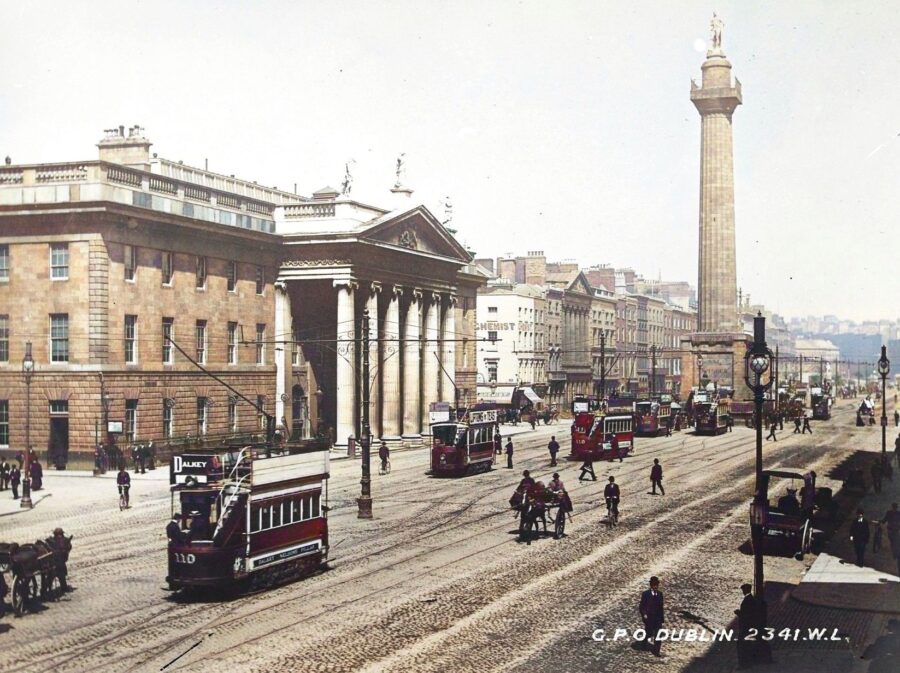
Architectural Style and Features
Johnston employed the Greek Revival style for the GPO, a choice that aligned with contemporary architectural trends favoring symmetry, grandeur, and the use of Greek classical elements. The facade of the GPO is dominated by a hexastyle portico featuring six fluted Ionic columns, supporting a wide entablature and triangular pediment. This setup not only added to the building’s majestic appearance but also symbolized stability and order.
The original design included the royal coat of arms in the tympanum above the columns, a feature removed post-independence to reflect Ireland’s changed political landscape. The building’s exterior was constructed predominantly from Wicklow granite, with the finer details and the columns of the portico crafted from Portland stone, ensuring durability and visual impact.
Initial Purposes and Functions
Beyond its architectural significance, the GPO was designed to serve multiple functional roles. It housed the main postal services of Dublin, dealing with the collection, sorting, and dispatch of mail. Additionally, it accommodated the administrative offices of the Postmaster General, integrating operations crucial for communication across Ireland and the British Isles.
The GPO also featured advanced security measures, including a bullion room and gun room, underscoring its importance in handling sensitive information and valuable items. Its strategic location and robust construction were intended to symbolize governmental authority and efficiency in public service, making it a focal point not only for postal services but also for civic administration.
Role in Irish Independence
The General Post Office (GPO) in Dublin is etched into the annals of Irish history due to its significant role in the 1916 Easter Rising, an event that catalyzed the subsequent Irish struggle for independence from British rule.
Selection as Rebel Headquarters
During the planning stages of the Easter Rising, the leaders of the Irish Republican Brotherhood, James Connolly, and the Irish Volunteers chose the GPO for its strategic and symbolic importance. Its central location on Dublin’s main thoroughfare, O’Connell Street (then Sackville Street), ensured that any action taken there would be highly visible and likely to attract public attention. Moreover, the building’s robust structure made it a formidable stronghold in the event of a siege or battle. On the afternoon of April 24, 1916, the rebels, led by Patrick Pearse and James Connolly, among others, stormed the GPO and quickly established it as the headquarters of their operation.
The Easter Rising at the GPO
Once the GPO was secured, it became the nerve center for the rising. Patrick Pearse, one of the key leaders and a figurehead of the rebellion, stepped outside the GPO to read the Proclamation of the Irish Republic to a gathering of confused Dubliners, declaring the establishment of an Irish Republic and the end of British rule. This moment, occurring early in the uprising, was a profound declaration of Irish sovereignty and national identity.
Inside the GPO, the atmosphere was tense and frantic as the rebels prepared for the expected British counterattack. The building served not only as a military command post but also as a makeshift communications hub, from which orders were issued to other rebel positions across Dublin.
As the week progressed, the GPO and the surrounding area became the focal point of intense fighting. British forces, realizing the significance of the rebel stronghold, concentrated their efforts on recapturing the building. Artillery fire pounded the GPO relentlessly, leading to significant damage. The interior was gutted by fire, which eventually made the position untenable for the rebels.
The Surrender and Aftermath
By the end of the week, with the GPO largely in ruins and the situation increasingly dire, the decision was made by the rebel leaders to evacuate and surrender to prevent further loss of civilian life. The surrender marked the temporary defeat of the Irish revolutionary effort, but the actions taken at the GPO ignited a powerful and lasting spirit of nationalism across Ireland.
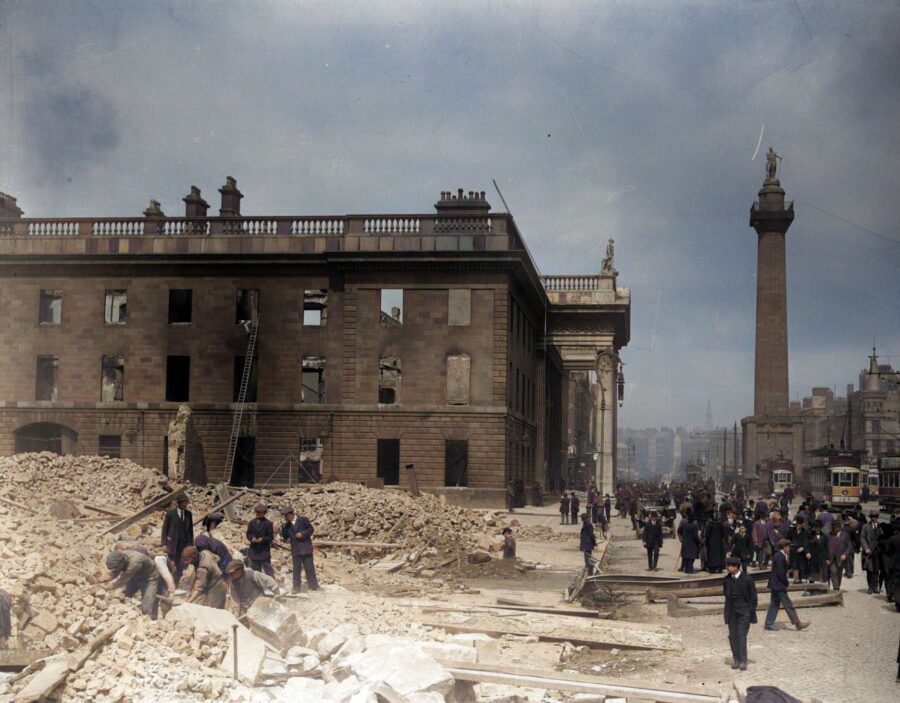
Post-1916 Developments
The General Post Office (GPO) in Dublin endured significant damage during the 1916 Easter Rising, necessitating extensive rebuilding efforts and leading to several changes in its structure and function over the ensuing decades.
Damage and Reconstruction
The aftermath of the Easter Rising left the GPO severely damaged. The building was engulfed in flames during the conflict, which resulted in the destruction of its interior and roof. The iconic façade survived, but the interior needed complete reconstruction. The task of rebuilding the GPO began shortly after the Rising, with the aim of restoring it to its former status while incorporating modern facilities suitable for the 20th century.
Reconstruction efforts were extensive and carried out under the direction of the Office of Public Works. The architects aimed to preserve the historical exterior while completely modernizing the interior. The work included reinforcing the structure to ensure its longevity and resilience. By the late 1920s, the GPO was reopened, featuring a blend of the original neoclassical design elements with new Art Deco influences, particularly noticeable in the interior fixtures and fittings.
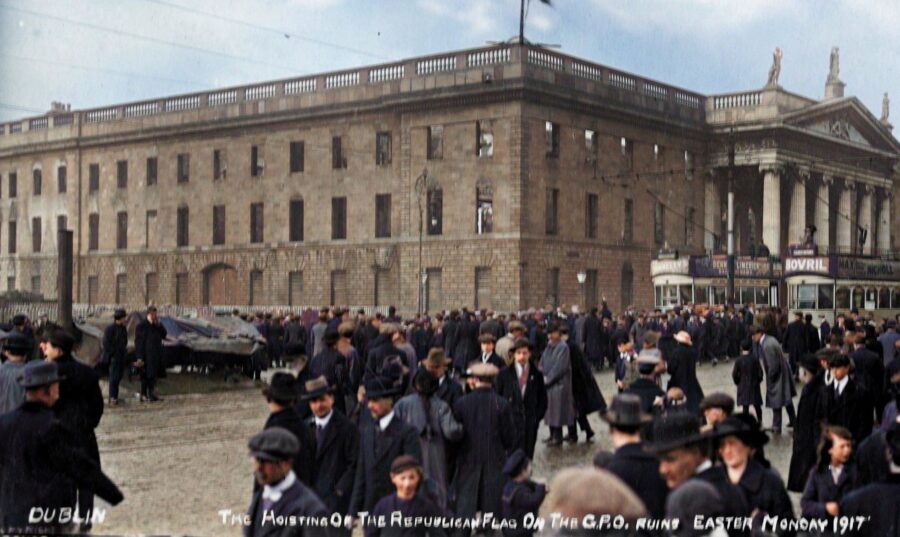
Structural and Functional Changes
Over the years, the GPO has undergone several renovations and upgrades to accommodate the evolving needs of postal services and to enhance its role as a public space. One of the significant additions was the introduction of a dedicated visitor center, which opened in 2016 to mark the centenary of the Easter Rising. This center, known as “GPO Witness History,” is a multimedia exhibition space that offers insights into the GPO’s role in Irish history, particularly its pivotal part in the 1916 Rising.
The building’s function has also expanded beyond traditional postal services. It has become a cultural and historical landmark, hosting various exhibitions and public events that celebrate Irish heritage. Furthermore, the GPO continues to serve as the headquarters for An Post, Ireland’s national postal service, reflecting its ongoing importance as a hub of communication.
Modern Additions
In recent years, the GPO has seen the introduction of modern technological facilities to keep pace with digital advancements and changing consumer expectations. This includes the modernization of its postal and customer service facilities to enhance efficiency and service delivery. Despite these changes, care has been taken to ensure that any additions respect the historical integrity of the building.
Modern Uses and Functions
The General Post Office (GPO) in Dublin has evolved significantly from its original role as a simple mail handling facility to become a multifaceted hub of activity in the heart of the city. Today, it not only serves as the headquarters of An Post, Ireland’s national postal service, but also as a vibrant public space that plays an integral role in national celebrations and demonstrations.
Headquarters of An Post
As the headquarters of An Post, the GPO remains central to Ireland’s postal and communications infrastructure. It houses the administrative offices where key decisions regarding the management and strategic direction of the postal service are made. The building’s historical significance and central location underscore its continued importance in the functioning and identity of An Post.
Daily Operations and Workforce
The GPO is a bustling center of activity with around 900 people coming to work daily. These employees engage in a variety of roles, from administrative tasks to customer service, handling the complex logistics of mail sorting and distribution. The building has been adapted to support modern postal services, including advanced sorting technology and customer service centers, which facilitate efficient communication and parcel delivery across Ireland and internationally.
Symbol of Public Service and Civic Engagement
Beyond its operational role, the GPO holds a special place in the hearts of the Irish people. It stands as a symbol of resilience and national pride, a site where history has been made and remembered. As such, it frequently serves as a backdrop for public service events, national celebrations, and significant commemorations, particularly relating to its role in the 1916 Easter Rising.
The GPO also continues to be a focal point for protests and public gatherings. Its historical and symbolic significance makes it a natural gathering place for citizens engaged in civic activism. Whether celebrating significant national events, such as the centenary of the Easter Rising, or hosting protests that reflect the public’s engagement with contemporary political issues, the GPO remains a central stage for expression in Irish public life.
Multifunctional Public Space
In recent years, the GPO has also embraced its role as an educational and cultural venue. The “GPO Witness History” visitor center, which opened in 2016, offers interactive exhibits and educational programs that explore the GPO’s role in Irish history, particularly its involvement in the 1916 Rising. This center not only enhances the cultural and historical understanding of the GPO’s significance but also attracts tourists and school groups, adding to its function as a public learning space.
Cultural and Commemorative Significance
The General Post Office (GPO) in Dublin holds a deep cultural and commemorative significance, not only as a historical site of the 1916 Easter Rising but also as a recurring motif in Irish literature, media, and public memory.
The GPO in Literature and Media
The GPO has been immortalized in a multitude of cultural works, reflecting its emblematic status in Irish history. It appears in literature where authors have drawn on its symbolic resonance—its façade and its role in the Easter Rising often serving as powerful metaphors for resistance and national identity. Notably, the GPO is mentioned in James Joyce’s “Ulysses,” where it stands as a poignant reminder of the aspirations and tumult of the Easter Rising, linking the personal and political in the tapestry of Dublin life.
The building has also featured in films and documentaries that explore the themes of independence and identity, illustrating its entrenched place in the narrative of Irish nationalism. Through such depictions, the GPO transcends its architectural significance to become a symbol of collective memory and national consciousness.
Memorials and Exhibitions
Inside the GPO, the cultural and historical legacy is actively commemorated through various memorials and exhibitions. The most notable of these is the “GPO Witness History” visitor center, which opened in 2016 to mark the centenary of the Easter Rising. This interactive exhibition is located within the historical building, offering visitors insights into the pivotal events of 1916 through immersive displays and artifacts that tell the story of the Rising, the people involved, and the subsequent impact on Irish society.
The visitor center not only serves as an educational resource but also as a space of reflection and remembrance, where the narratives of the past are preserved and passed on to future generations. It includes a commemorative courtyard with inscriptions and exhibits that pay homage to the leaders and participants of the Rising, contextualizing the GPO’s role in these events.
Cultural Impact and Public Engagement
Beyond its role as a postal headquarters, the GPO stands as a living museum and a site of pilgrimage for those interested in Ireland’s fight for independence. The building’s historical layers are peeled back through guided tours and public talks that explore its architectural evolution and its enduring impact on Irish culture and politics.
Additionally, the GPO continues to inspire contemporary artists, writers, and filmmakers, who reflect on its legacy and reinterpret its symbolism in new and meaningful ways. This ongoing cultural engagement underscores the GPO’s role not just as a static monument, but as a dynamic actor in the cultural life of Dublin and Ireland.
Visitor Information
The General Post Office (GPO) in Dublin is not only a pivotal site in Irish history but also a must-visit destination for tourists exploring the city. Situated prominently on O’Connell Street, Dublin’s main thoroughfare, the GPO offers a blend of architectural beauty, historical significance, and engaging exhibitions.
Access to the GPO
The GPO is centrally located on O’Connell Street, making it easily accessible by public transportation. Visitors can reach the GPO via numerous bus routes that traverse the city center or by using the Luas tram system, with the nearest stop at O’Connell Street. For those driving, parking is available in several nearby car parks, though spaces can be limited due to the central location.
Museum and Visitor Center Features
The “GPO Witness History” visitor center is a highlight for anyone visiting the GPO. This award-winning exhibition space offers an immersive experience through interactive displays, original artifacts, and a narrated journey through the events of the 1916 Easter Rising, during which the GPO played a crucial role. The visitor center is designed to engage all ages, making it ideal for families, school groups, and history enthusiasts.
Tickets for the visitor center can be purchased online or at the entrance. It is advisable to book in advance during peak tourist seasons to ensure availability. The visitor center also includes a café where visitors can relax and reflect on their experience, and a gift shop offering a range of books, crafts, and memorabilia related to Irish history and culture.
Highlights of the Building’s Architecture
Visitors to the GPO are greeted by its imposing façade, featuring a classical portico with six fluted Ionic columns, topped by a pediment which once bore the royal coat of arms. This architectural style reflects the Georgian period’s admiration for classical Greek and Roman aesthetics, symbolizing stability and order.
Inside, although much of the original interior was destroyed and later reconstructed, the current design incorporates elements of both the classical and modernist styles. The public hall is particularly notable for its high ceilings and the intricate detailing on the stonework. Information plaques throughout the building provide insights into its architectural history and the significant events that took place within its walls.
Tours and Educational Programs
Guided tours of the GPO are available, offering deeper insights into its historical and architectural significance. These tours are led by knowledgeable guides who bring to life the dramatic events of the 1916 Easter Rising and discuss the building’s role in Irish society both past and present.
Educational programs are also offered, designed to engage students and adults alike in learning about the role of communication in national struggles for independence and how the GPO has evolved over the centuries.


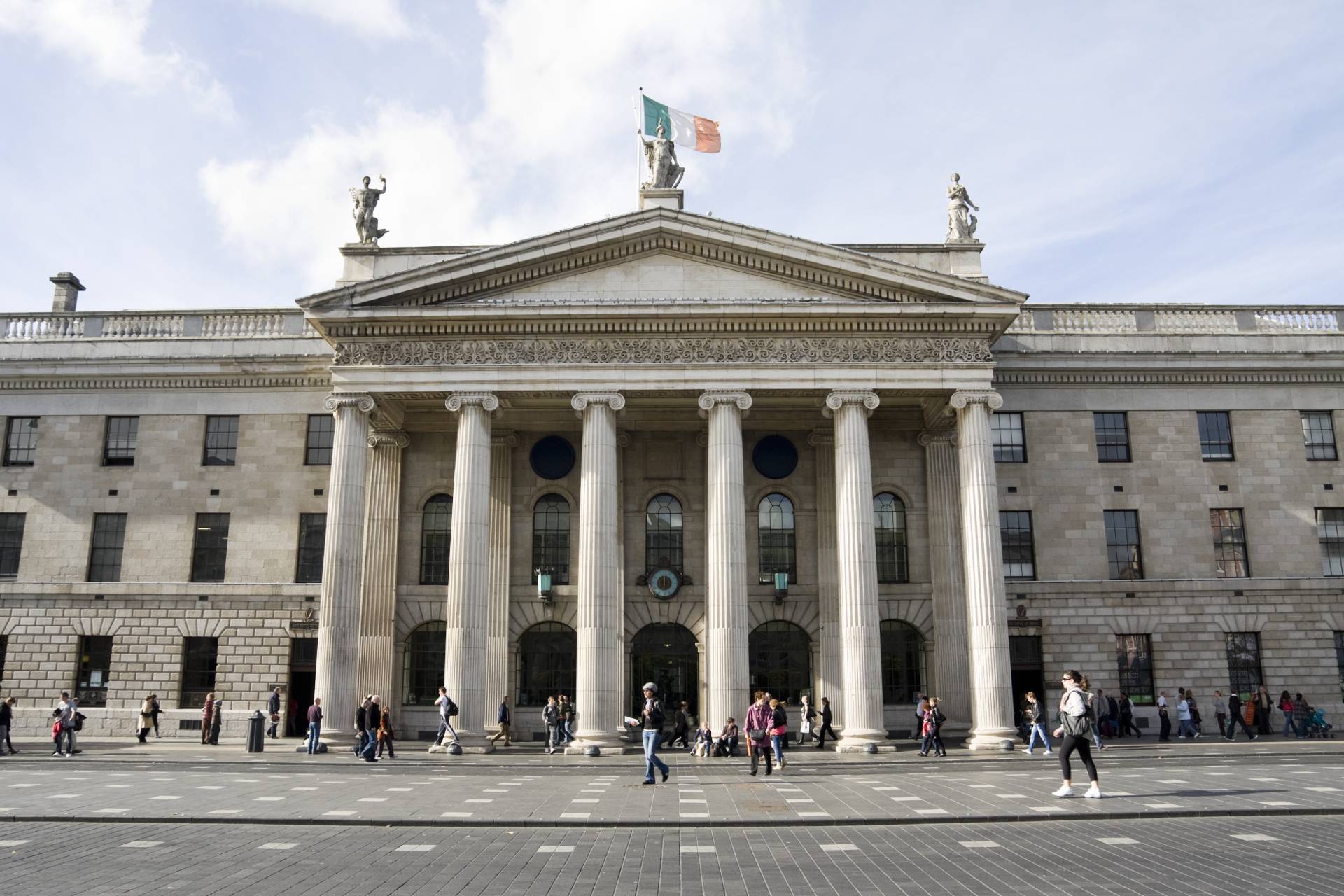
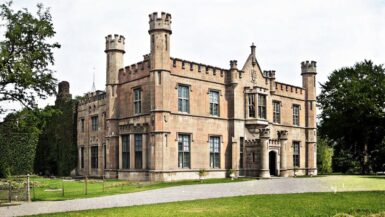
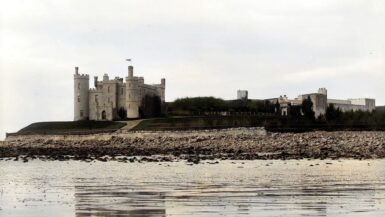
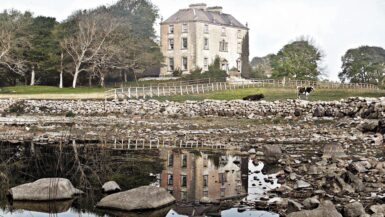
Leave a reply